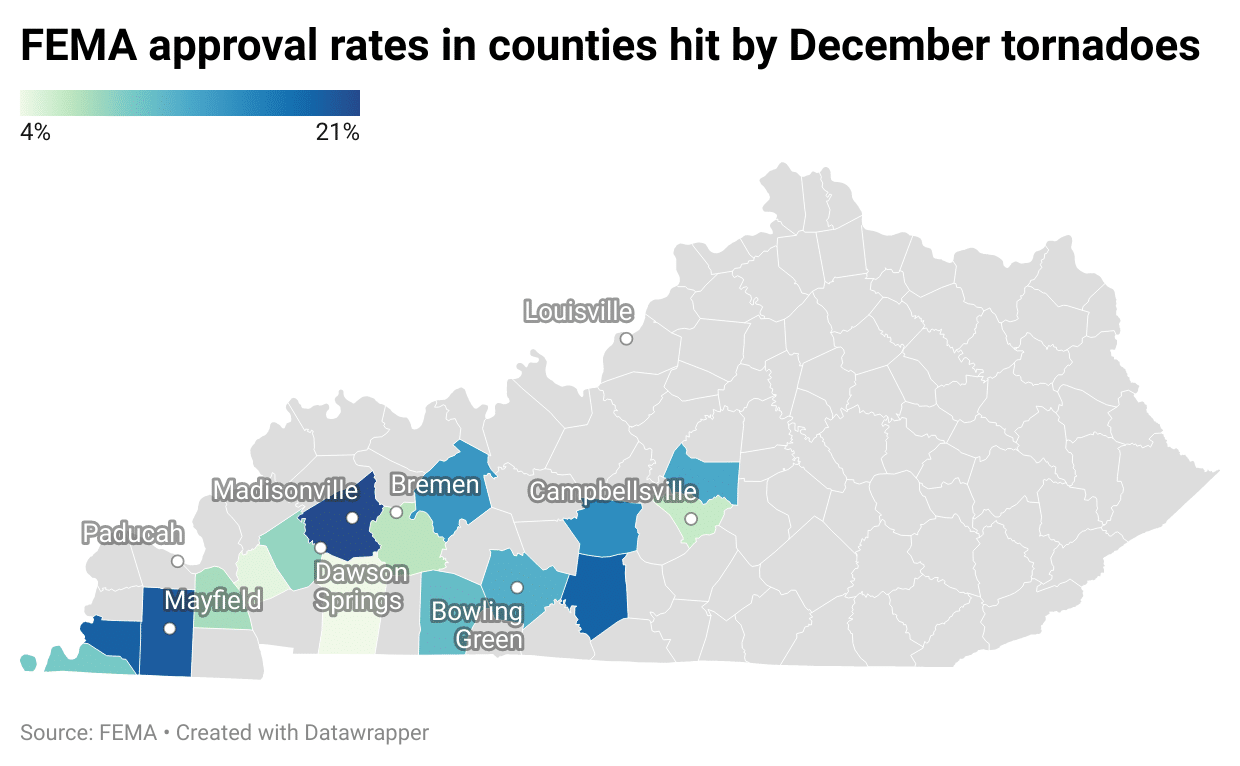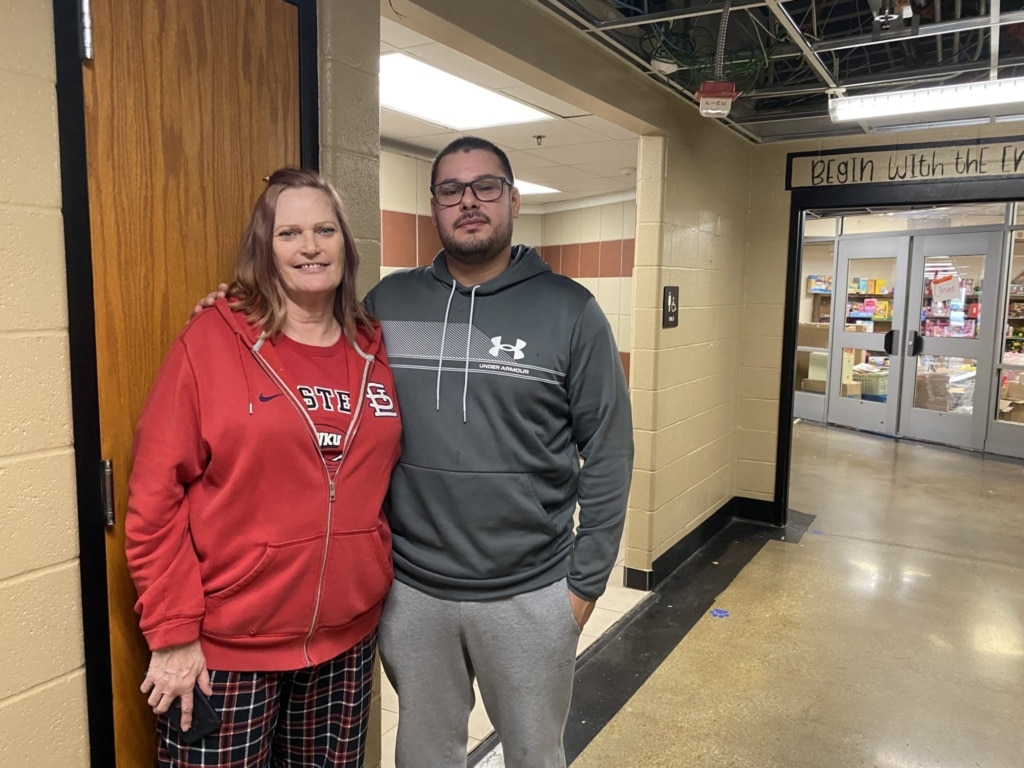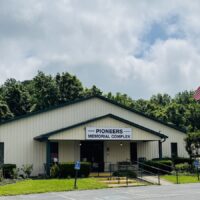Jonathan Shelton went room to room through an old elementary school-turned-donation center and stacked socks, washcloths, bedding into a shopping cart — the ordinary things he lost when a tornado swept through his neighborhood in early December.
Shelton, 29, doesn’t really like asking for help, but he needed some.
He applied for aid from the Federal Emergency Management Agency, hoping for a check to cover a temporary place to stay, replace some lost items or repair his car.
“Just anything helps, you know,” he said. “Especially when you lose everything.”
Shelton was surprised when the agency denied his request. He paid rent to a roommate, but his name wasn’t on the lease. To FEMA, that’s not a primary residence.
The federal agency’s mission is to aid people after disaster strikes by helping pay for temporary housing, repair damaged homes, or other critical needs like food, clothes or medicine.
But fewer than 14% of the 11,800 Kentuckians who asked for FEMA’s help within six weeks of the storm were approved for aid, according to a KyCIR review of federal data.
More than 4,300 applicants were considered ineligible for housing assistance because they missed or couldn’t be contacted for an inspection, according to the agency’s data.
Nearly 200 were turned down because FEMA officials could not verify their identity, address or that they owned the damaged property.
FEMA denied nearly 2,000 applicants after their application was withdrawn or duplicated, the data show. They are not included in KyCIR’s analysis.
Applicants have 60 days after a denial to appeal the decision.
- RELATED: Christian County eligible for low-interest USDA loans to repair agricultural damage from December tornadoes
- RELATED: Kentucky launches website with tornado recovery resources
In an emailed statement, a FEMA spokesperson said the agency could not explain the assistance approval rate because every applicant has a unique case, with unique circumstances.
“Survivors have every right to appeal FEMA’s decision, in writing, if they disagree,” said Alberto A. Pillot, FEMA assistant external affairs officer.

Rejections common
The historic tornado tore 160 miles across Kentucky, killing 77 people and causing billions of dollars in damages.
Since then, FEMA has provided more than $12 million in aid through the Individuals and Households Program, which includes housing assistance and other critical needs.
But in Facebook support groups, donation centers, and firehouses in western Kentucky, the stories of FEMA are often about getting turned down.
It’s a common issue nationwide. FEMA’s assistance approval rates have dropped in recent years into the teens, down from more than 60% a decade ago, according to a report last year from The Washington Post.
A 2020 report from the U.S. Government Accountability Office highlighted several challenges to seeking FEMA aid, such as requiring some people to first apply for a loan with the Small Business Administration — a requirement FEMA didn’t fully explain.
FEMA also has struggled to manage expectations, and needs to improve how it communicates with people seeking assistance, according to the report.
FEMA strives to help after a disaster, but they’re not the cavalry, said Simone Domingue, research fellow at the University of Oklahoma’s Southern Climate Impacts Planning Program.
“The unfortunate result is there are often some pretty critical gaps,” she said.
There are many reasons a person can be denied assistance, according to FEMA. Having insurance is a leading reason; the agency won’t pay for any damage covered by insurance.
The application process is the byproduct of a government system under pressure to respond to more and more disasters, said David McEntire, professor in the emergency services department at Utah Valley University.
“There are often people who are frustrated with FEMA and the amount they get or the time it takes to get it,” he said. “But FEMA is in a precarious position because they need to verify everything, with speed, and those things clash.”
A quick denial can be enough to make someone throw up their hands and give up.
That’s what Shelton was prepared to do after seeing FEMA denied his request for assistance.
“It was, like, they’re not going to do anything, you know?” he said.
His mother, Mari Taschner-Whitlow, however, worked for years in insurance and she’d dealt with FEMA in the past. She figured she’d meet face-to-face with a FEMA representative, explain her son’s situation and resolve the issue.

She went to the local disaster recovery center in Bowling Green — a hollowed-out Sears at the nearby shopping mall — and tried to set the record straight.
She also got her son’s roommate to submit a statement that the damaged home was Shelton’s primary residence, Whitlow said, an option no one told her son about. She’s hopeful the denial will be reversed and he’ll be eligible for some type of assistance.
But, three weeks later, they’ve yet to hear anything.
“FEMA came in and made it sound as though we’re saved. No, no,” she said. “I think most people have come to realize we’ve got to just rely on each other.”
‘FEMA cannot make you whole’
It didn’t take long for Patti Sawyer to see that the support from her community would outweigh the federal government’s.

She was hopeful after President Joe Biden came to Kentucky to tour the wreckage beside Gov. Andy Beshear.
“I thought it would be pretty obvious that someone would walk through the neighborhood and kind of be like, ‘You poor people, let us help you,’” she said.
And that’s largely what she heard, when Biden promised from amid the rubble in hard hit Dawson Springs that the federal government would be there to help.
“We’re going to get every single thing you need,” he said on December 15.
Sawyer’s home on a dead-end street in Bowling Green’s Whispering Hills subdivision sustained more than $60,000 in damage.
A few days after the storm, while staying at a friend’s house, she applied for FEMA aid and was rejected because she had insurance.
FEMA denied nearly 3,000 Kentuckians’ requests for aid because they had insurance coverage, according to KyCIR’s review of the agency’s data.
Having insurance is not a guarantee a person will be denied FEMA aid, but Pillot, the FEMA spokesperson, said it’s only intended to meet “basic needs.”
“FEMA cannot make you whole,” he said.
Sawyer’s home is still standing, and for that she considers herself lucky. After she was denied, FEMA directed her to apply for a Small Business Administration loan, but she’s not looking to take on debt.
“I’m not expecting …to come out ahead in this,” she said. “But I’d like to come out where I left off, before this disaster hit.”
Now, she’s not too hopeful that will happen, and she’s learning to accept it.
“This is Kentucky,” she said. “We’re gonna dig in and we’re gonna rebuild. We’re gonna do what we need to to clean up. We’re going to help each other.”
Contact reporter Jacob Ryan at jryan@kycir.org. This article first appeared on Kentucky Center for Investigative Reporting and is republished here under a Creative Commons license.
Jacob Ryan joined the Kentucky Center for Investigative Reporting in December 2017. For three years prior, he worked as a WFPL News reporter. Ryan is originally from Eddyville, Kentucky.






